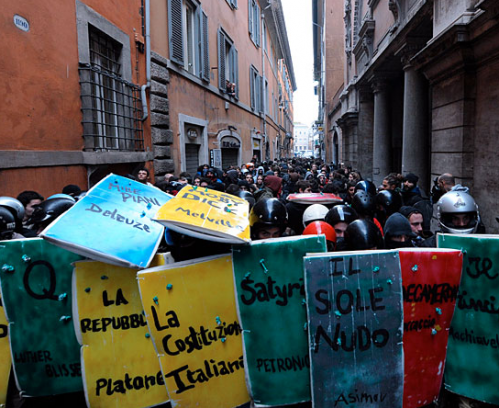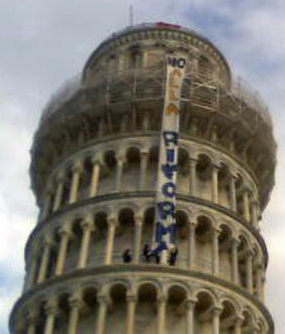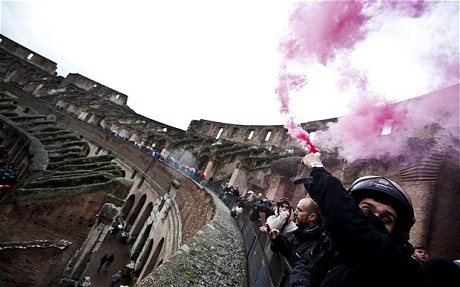Regime-Busting Times? Notes on the Student Protests in Italy
With Berlusconi facing a vote of confidence on 14 December, the widespread student protests present a destabilising verdict on 16 years of misgovernment
God knows what the Italian riot cops, lined up to protect the ‘sacred' doors of the Senate building in Rome, must have thought. All set and ready for action, they faced a line of university students protected by shields painted to look like book covers. From Boccaccio to Luther Blissett and Henry Miller to Deleuze, the students' literary selection was as omnivorous and diverse as the cultures they represented - and likely rather more all encompassing than police academy reading lists. The colourful props proved their usefulness minutes later when the police started slamming down their batons on the students' attempt to break into the hall of the upper chamber, creating some immortal memorabilia and the perfect cover images for the whole protest movement: pictures of the nation's armed forces beating up the classics, the state kicking the shit out of culture.

Image: The tome is far mightier than the shield. Students in Rome, November 30 2010
Protest
Italy has not seen such widespread and committed unrest around education in quite a while. Campuses are occupied countrywide with students, researchers, teachers and professors all involved in denouncing a reform that condemns researchers to life-long precariousness, cuts funding to public education while doubling that of private (in many cases catholic) institutions, and reinforces the role of administrators who have more to do with politics than academia. Furthermore, the reform comes ahead of the budget's approval, leaving many doubts about the actual ability of the government to fulfil even their small promises of investment.
News of students' protests would usually not generate much interest in Italy, where occupations and marches are some kind of seasonal event, yet this time it's quite different. A series of unconnected events have recently put Berlusconi's government under a lot of pressure, and technically the coalition sustaining the executive no longer has a majority in parliament. A vote of confidence that is likely to be the epitaph for Berlusconi's political fortunes, has been scheduled for the 14 December, yet the government is trying to bulldoze the reform through, hanging on to it as their last chance to prove they can run the country.
Recent events painted a sorry picture of Berlusconi's declining public and political persona. The failure of his government's programme and scandals involving him or his fellow party members are finally taking their toll leaving him, for once, outsmarted. The state of things is another picturesque chapter in Italy's lively politics, and the climax of Berlusconi's 16 year role as its main protagonist. Now, the end of the so-called Second Republic seems nigh, and the outcomes are as unpredictable as they were in 1993, at the beginning of Berlusconi's political rise. The protests against the university reform proposed by the Minister for Education Mariastella Gelmini overlap with a wider discourse around education, and has to be read in conjunction with the political crisis.
Times of Trouble
The last, colourful few months of Italian politics featured the following key events: a couple of casualties among government ministers due to bribery scandals; the sudden epiphany of Berlusconi's former main ally Gianfranco Fini (previously leader of post-fascist MSI, then of the National Alliance, which morphed in 2008 into Berlusconi's People of Freedom party), who turned his back on the PM, dismissing the government as weak and incapable of carrying out the job, and calling for the latter's resignation; growing public unrest for the government's populist attempts to minimise the failure of their response to the earthquake that shattered the central region of Umbria; and the rubbish filling up the streets of Naples.
Add to that the usual sex scandal: if you are the Prime Minister of a country with very strict and ideological immigration laws - written by members of your coalition who regularly make racist statements on political talk shows reminiscent of pre-Question Time Nick Griffin - you probably should avoid calling a local police station to ensure that a 17-year old Moroccan girl, without a visa, should be immediately released from detention because she is apparently the niece of the Egyptian president Hosni Mubarak, while in fact she is a regular attendee of the exclusive parties at your villa (google bunga-bunga for more details).
PR for Dummies
The depth of the crisis, which recent protests have made clearer still, has given rise to a series of grotesque reactions by senior figures close to the PM, giving a sense of unusual communication chaos. One of the most entertaining moments was when a senior government-backing TV journalist, Emilio Fede, congratulated the police for 'beat[ing] up students' during the live broadcast of his daily news show. Just a meaningless act of loyalty towards the government - an attitude not uncommon among a largely biased range of TV personalities - in a country in which the prime minister controls half of the terrestrial broadcasting via government influence, and the other half through private ownership, perhaps. But one that betrays a certain under-estimation of the context. In one sense, portraying dissent as ‘violent' and ‘terrorist' is the mainstream media's usual way of delegitimising protest. It was the strategy that successfully persuaded the majority of the Italian public that the killing of Carlo Giuliani during the G8 demonstrations in Genova, 2001, was justified. It was enough back then, but it might not work this time around. Education as a debate involves such a big chunk of the Italian population that attempts by governmental media to distract the public from the issues at stake is not as straightforward as it was when the ideological anti-globalisation movement was their target.

Image: Students bring Italy's picture postcards to life
Moreover, in recent years, Berlusconi's PR strategy has shifted away from polarising political discourse among the two coalitions - his party against the resurgent communists - or nicknaming the People of Freedom Party the party of love as opposed to the hatred embodied by the child-eating Stalinists on the other side. His strategy has always been based on populism and repetition, a pretty basic propaganda formula, which worked so well courtesy of the inconsistency of the parliamentary left opposition. Now that dissent has spread and diversified, a party and a leader who always based their success on popularity and appeal are left outwitted and trailing in the polls.
Thus it seems Berlusconi is losing his grip on his formerly impeccable PR strategy. The caricature of hyper Italianness he portrayed with his public persona, the joke-telling, moneymaking, models-fucking president, supremely able to portray himself as the man who takes things in hand, is now comically tripping over the very means of his former success. Very much in the fashion of the television he produced and the magazines he published, Berlusconi's popularity was due to his ability to sell himself as the stereotype of what some Italians would love to be seen as. Not quite that brand of Italian culture popularised abroad by neorealist cinema and the visual arts, but rather that of its farcical comedy, dirty jokes, footballers, glamour models and topless dancers on prime time TV.
Postcards from Italy: Contemporary Situationism
A champion of low culture, accompanied by the finest brand of conservative populism - God, land and family (with some charming leeway in the latter category) - Berlusconi's era is mostly about the dumbing down of what the public perceive as culture within the country. The rise of cheap entertainment and popular TV went hand in hand with the government's utter disinterest for Italy's historic, classical heritage. The students' protest re-established that forcefully during the whole of last week when marches and assemblies followed the occupation of some postcard-worthy national monuments.
The Colosseum, the Leaning Tower of Pisa, the Cathedral of St. Mary in Florence and Venice's St. Mark's, are among the locations selected by the protesters for peaceful occupations. The actions are meant to re-establish the public ownership of monuments of national interest and highlight the synergy between education and culture, thereby subtly asking the government to take an interest in areas seemingly far from their 'ethos' and investment-chasing priorities.
The occupation of monuments by students, researchers and university staff highlights the reaction against the carelessness shown by the Ministry of Culture, that has allowed part of the Roman ruins of Pompei to sadly and silently crumble - the minister responsible, Sandro Bondi, has since spent his time passing the buck. The occupation of places that are worldwide symbols of Italy, but have somehow been left to rot by dysfunctional bureaucracy and poor administration, is a claim for the need to rediscover a politics that takes culture into account, after the latter has been treated as a liability rather than an opportunity.
It is interesting and effective that the students have chosen a more suggestive approach from the straightforward pattern of demonstrating within the means of political dialectics. Style has been as significant as political discourse in the rise of beyond-politics Berlusconi - style is proving a main issue in his decline. Italy is not simply witnessing the debate over systemic reform of universities, but rather a clash over the future of Italy in which spontaneous actions and civil responsibility are taking on stuttering parliamentary oppositions.
The Delayed Ecstasy of Communication
Protesters have learned how to use the internet for their cause while their government is still investing in terrestrial-digital decoders to further enrich a few closely connected manufacturers. Experiences such as that of Beppe Grillo - a comedian turned counter-information blogger who managed to gather a huge network through his website and structure a political movement that took part in local elections in several parts of Italy during the last electoral round - highlighted the strengths of new patterns of communication in a country where television still plays the dominant role. This could serve as a good metaphor for popular discontent over the ‘speed' at which the country is moving.

Image: Students in the Colosseum, 26 November 2010
Reading Italian papers or watching the few TV shows not directly in thrall to the Prime Minister's press office, one can detect a timid sense of the regime's imminent demise. Not that this would necessarily guarantee a better future, given the human material that composes Italian politics, yet after 16 years of Berlusconi one learns to appreciate the small things. There is a discreet but growing will to dismantle a system of power that has reached the end of the line. The students and researchers who are occupying streets and monuments, camping on the rooftops of their faculties, blocking train stations and breaking into local councils are sounding a final call to arms. It's happening now. No certain outcome, but at least it's happening.
Ending 1 - Relief
The commitment of the student protesters is like the reassuring comedown after a disturbing trip. It is the testimony of a process that involves every aspect of the country's political and social life. People are slowly realising that claims of non-stop conspiracies and corrupt trials, often resolved by specifically tailored government laws, can only work with retarded audiences. That having an army of clones to spread out across TV debates and talk over others without really having much to say can be effective only until people start listening. That a 74-year old man addicted to hookers is not cool, but really quite sad. That the whole of the international press questioning his suitability as leader of a First World country is not down to the secret manoeuvrings of the Communist International. That a western government that sees immigration as a threat and reduces the legal immigrant workforce to second class citizens by means of the law is a tiny bit obsolete.
Ending 2 - Futures
The way I understand it, the student protest is the last big happening of what Italian commentators have called the Second Republic. On 14 December this government will pack and go, and quite likely general elections will take place early next year with a new balance of alliances and possibly a few surprises. As already mentioned, this is no guarantee of an improvement; one has only to look at milestones in Italian history to see that the hanging of Mussolini produced the First Republic - and thus corruption, mafia infiltration, the strategy of tension and much more - and the end of the latter produced Berlusconi. The future is uncertain, yet the streams of resistance gathering in the streets seem strengthened by a new understanding - and we are not yet ready to accept defeat, as we have done so many times before.
Andrea Tocchini <andrea.tocchini AT yahoo.co.uk> is a writer - and he has never voted for Berlusconi.
Mute Books Orders
For Mute Books distribution contact Anagram Books
contact@anagrambooks.com
For online purchases visit anagrambooks.com






